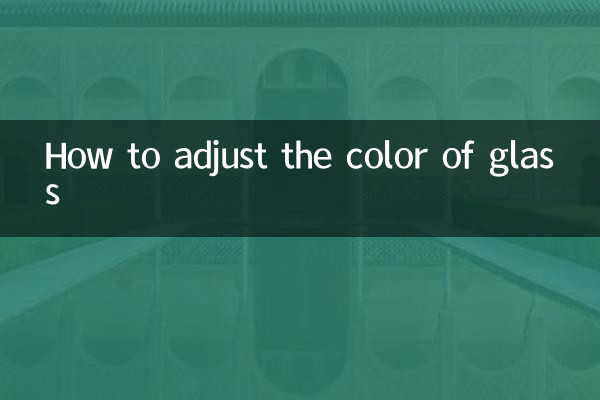How to adjust the color of glass
In modern design and manufacturing, color adjustment of glass is an important technical link and is widely used in the fields of architecture, home, automobile, art, etc. This article will combine popular topics and hot contents across the network for the past 10 days to analyze the methods, principles and practical applications of glass color adjustment for you in detail.
1. Basic principles of glass color adjustment

The color of glass is mainly determined by its chemical composition and manufacturing process. The light transmittance and color of the glass can be changed by adding different metal oxides or adjusting the production process. Here are common colorants and their corresponding colors:
| Coloring agent | color | Application scenarios |
|---|---|---|
| Iron oxide (Fe₂O₃) | green | Building glass, wine bottle |
| Cobalt oxide (CoO) | blue | Art glass, decorations |
| Copper oxide (CuO) | red | Signal lights, stained glass |
| Manganese oxide (MnO₂) | Purple | Church glass, crafts |
| Chromium oxide (Cr₂O₃) | yellow | Automotive glass, solar panels |
2. Common methods for adjusting glass color
1.Chemical coloring: The color of the glass is directly changed by adding metal oxides or other colorants to the glass raw materials. This method is suitable for mass production and has high color stability.
2.Coating coloring method: A metal or metal oxide film is plated on the surface of the glass, and the color is changed through the interference or reflection of light. This method is commonly used in architectural glass and automotive glass.
3.Heat treatment method: By controlling the heating and cooling process of the glass, it changes its internal structure, thereby affecting the color. This method is mostly used in artistic glass and crafts.
4.Spraying method: Use special pigments or paints to spray the glass surface to achieve color adjustment. This method is simple to operate, but has poor durability.
3. The practical application of glass color adjustment
1.Construction field: Stained glass is widely used in curtain walls, windows and decorative materials, which can not only meet aesthetic needs, but also regulate light and temperature.
2.Home Design: Stained glass is often used in furniture, lamps and partitions, adding an artistic atmosphere to the interior space.
3.auto industry: The color adjustment of car glass can not only improve the appearance, but also reduce the UV transmittance and protect the people in the car.
4.Art creation: Stained glass is a common material for churches, museums and artworks, and can express rich themes and emotions through color adjustments.
4. Technical trends in glass color adjustment
1.Smart color-patching glass: With the development of technology, smart glass can automatically adjust the color according to ambient light or user needs, and is widely used in the fields of construction and automobiles.
2.Environmentally friendly coloring technology: Reducing the use of heavy metals and developing more environmentally friendly colorants and processes are important directions for future glass color adjustment.
3.Nanotechnology application: Change the optical properties of glass through nanomaterials to achieve richer colors and higher light transmittance.
5. Summary
Glass color adjustment is a comprehensive technology that combines chemistry, physics and art. Through different colorants and methods, colorful glass products can be created to meet the needs of different fields. In the future, with the advancement of technology, glass color adjustment will be more intelligent, environmentally friendly and diversified.
I hope this article can provide you with valuable information. If you have more questions or needs for glass color adjustment, please feel free to discuss it further.

check the details

check the details